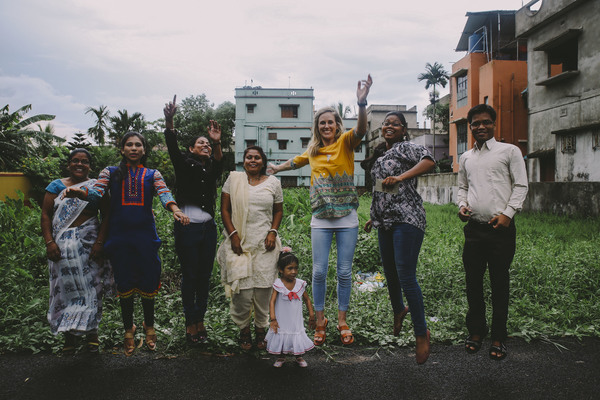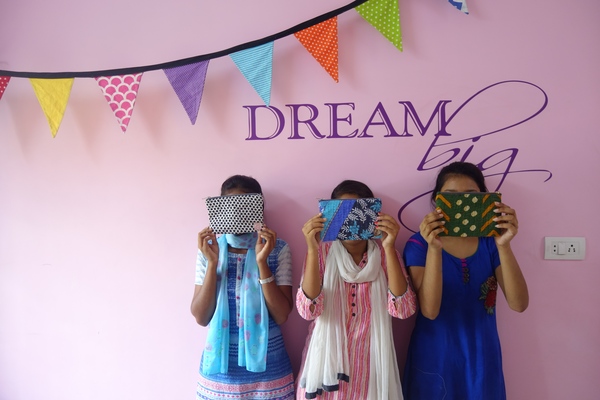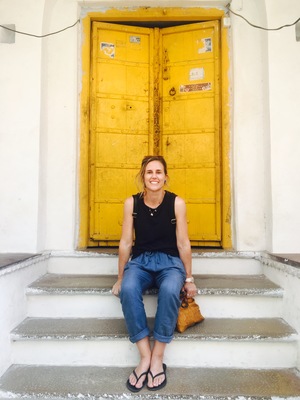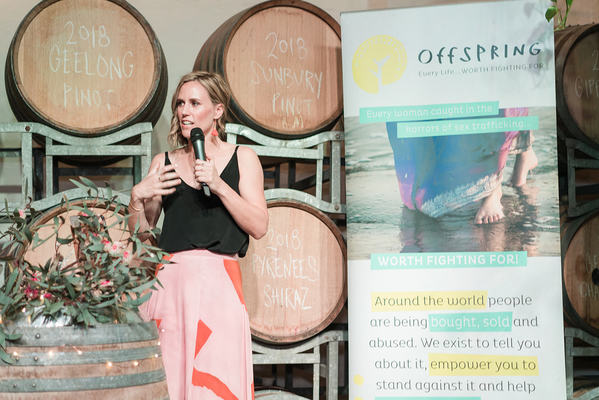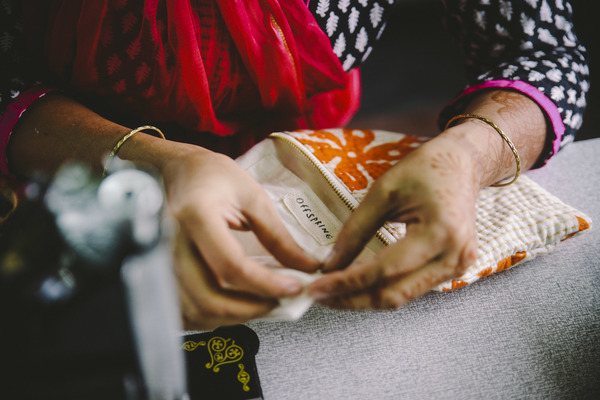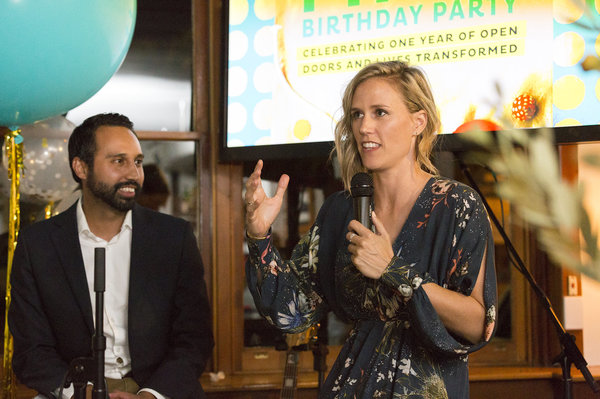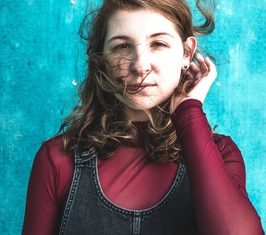By Elissa Friday
From teaching at Christian College to saving victims of sex trafficking in Calcutta, Kristi Van Es has seen the highs and lows of humanity. She tells ELISSA FRIDAY about her remarkable work with Offspring, the charity she established to help some of the world’s most disadvantaged women and girls.
Kristi, please tell us about your family background.
I’ve got an older brother and younger sister who now live in Melbourne. I’ve always lived in Moolap and have been there for the past 25 years of my life.
I have a boyfriend, which is interesting when you spend most of your time in India.
Pete and I have been together for 18 months, initially meeting when he came over to talk with me about the organisation he works for. We soon realised our common ground.
He works one day a week for a non-profit organisation in the anti-trafficking field, which raises funds for partner organisations throughout Asia.
You were a local teacher a few years ago?
I started teaching in 2005 at Christian College, middle school campus. Then I went across to the Bellarine campus teaching for around six or seven years there.
I loved my job. It was great to get up in the mornings and go to work thinking, ‘I’m getting paid for doing this’.
Also, it wasn’t about how well they threw the ball during sports class. It was more about me helping them through challenging years.
Tell us about your first experience in India.
I first went on a group trip to the south of India when I was 19 and still to this day have a love-hate relationship with it.
I loved it because of the constant things going on all the time. I struggled in some ways with the cultural difference. Plus, I got pretty crook, and at one point I was lying outside with an intravenous drip that was just attached to a bit of wood they had made on a makeshift bed. I did get better, though, and whatever they dosed me up with helped.
I don’t try to figure what it is any more that makes me unwell, I just figure out how to get better.
What was it about India that lured you back?
It was an organisation called Teen Missions that worked with taking kids on experiences to places like Fiji.
All the places they went seemed nice but India was somewhat intriguing to me. I think because I like a challenge and that was going to be one.
You included India again in your future travels?
I took a year leave from work and we worked in the Aboriginal community right in the centre of Australia, in Armada, just underneath Uluru. I was the swimming and sports teacher for a term.
We then travelled to Africa and were working with a few different organisations there. After that, travelled through Europe for six months and then went to India for two months in 2010 for the second time when I was 27.
Tell us about your third trip to India and how it inspired you to make a fundamental decision.
I went back in 2011, taking with me a small group of people on a two-week exposure trip looking at rural and urban poverty. I said to them, ‘This is what I’m looking at doing here and why, and this is how much it will cost for the trip’, and so on.
I was trying to lead people on a similar experience to what I saw in terms of how we live in such a privileged culture and world. I thought, ‘Let’s have a look at what’s going on over on the other side of the world and look into doing something about that’.
During the trip we visited an organisation called Justice and Care, which goes into the venues and rescue girls from sex trafficking.
For me, that was my first real exposure to human trafficking.
So you decided to resign from your teaching job?
At the end of 2012 I resigned and got on a plane to India.
I spent 2013 as a research year, working with different organisations, figuring out what the need was, and if there were similar organisations there. I felt ready to come on board alongside others but I was also ready to fill a gap.
It came from meeting a girl who had been trafficked from China into Greece. I was in Greece at the time and when she was free she looked at me and said, ‘But I’m still like a baby’.
All of her life she she’d had no independence, so for her to be free and let into the world with no skills or knowledge inspired me to want to help break that cycle of them feeling still vulnerable to going back into what they were rescued from.
You were inspired to open a charity there?
Doors just kept opening, giving me the opportunity to come to India. I felt that I couldn’t not do something, and part of that is my Christian faith. I just wanted to love people and these were the people that I felt like I needed to love.
We have been a registered charity since 2014. I did my research year and spent two years setting up the organisation in India, in Calcutta, before we actually had our first sex traffic survivors.
There were heaps of challenges for me in a new country, culture, language, new everything. I was working on finding a place to live, finding our first staff member and office and so on.
How did you decide on the name Offspring for your charity organisation?
It came from a verse in the Bible, which I had read when I was in Greece travelling in 2010.
I was standing in the spot where Paul had preached to the people of Athens. I asked a guy about it, and was told what Paul had preached was in Act: 17, so I read it. It said: ‘In him we live and move and have our being. We are his offspring’.
I wasn’t planning on setting up an organisation then but I love that word, offspring. We’re someone’s child and that’s important, offspring for life.
What is the process for rescuing the girls?
These guys from the organisations are going into the brothels undercover, pretending to want these girls but obviously not doing anything. They talk to the girls and explain why they are undercover there.
Huge risks are involved for those undercover. They put their lives on the line for girls they don’t know, which really got me thinking about what are we here doing about it.
How big is the sex trafficking Industry?
It’s massive.
Modern day slavery is another word for human trafficking. It’s bigger now than it’s ever been. Part of that is sexual exploitation and forced labour.
There are a lot of different areas in it. With females, sex trafficking is the biggest.
There are a lot of areas where people are forced into slavery, with no choice, such as forced labour in garment factories. We decided to hone into one area.
How are women trafficked? What is the process?
People struggle to understand that concept, which I did when I first heard about human trafficking. I thought to myself, ‘How does this happen? How does someone exploit someone in that way?’.
The biggest factor is vulnerability, which comes from poverty, which comes from a lack of education, and the low status of women in society.
From what we’ve seen with the girls we have with us it’s the parents who either can’t afford to have a girl child and then sell their daughter into the industry, or unknowingly they send their daughter to a job in the city so she can send money back to the family and it all sounds great but it’s not.
In India you have to pay a dowry for a daughter when she gets married and is about to live with the husband’s family. They would not really see their daughter after that, and she wouldn’t be sending money home. Whereas when a boy marries his family gets a whole lot of money and then his family has another female in the household helping out with all the jobs.
I can’t judge people for the decisions they make when I haven’t had the experiences they’ve had.
Does trafficking include children?
One of the girls we have is now 21, and she was trafficked at the age of four.
She moved from one side of the country to the other. She doesn’t know her original family and was rescued at the age of around 16, so, yes, they are trafficked often at a younger age because there are more profits for a younger girl.
Men are also trafficked?
Men generally will be trafficked more for forced labour but there is also definitely trafficking for sexual exploitation of boys.
Where is this most rife?
They say there’s not one country that’s not affected by modern slavery.
In terms of sex trafficking, I’d say it’s in the Asian countries where it happens the most.
What are some of the long-term effects for the victims?
We see girls having really high and low mood swings, also being on medications for schizophrenia, for depression, and having flashbacks when they’re with us. We do see the effects and try to have an impact on them in a positive way.
Are there deaths?
Not for us personally with the girls we’ve had but we have heard stories from one of our girls about another girl within her community who was rescued and went back into the community and then not long after was murdered.
If the traffickers feel like the girls are going to testify or say anything these girls are still at risk, or there may be stigma from within the community, so there are lots of risks involved.
Is it a high-end industry?
Not in India.
I walked past the red light area with one of my staff members and a woman came up to him and spoke. I asked what she had said – she had offered herself to him for the equivalent of 50 cents. The effect of hearing this impacted him so much, learning how someone can give up their body for such a low amount of money.
In India it ranges. People will pay money for a younger female or a virgin, and there are people who are also willing to pay low amounts of money for sex.
Do they women get much of the money?
The money mostly goes to the pimps and to the traffickers.
The females might get some but that’s part of the manipulation, part of the way to keep them there. It goes back to the vulnerability, of always being in poverty and the hope they have some money to save up and give to their family, which leads to the feeling of needing to stay in that place for their family. It’s a trap.
The manipulation and the lies involved almost make it so they don’t have a way of leaving, and it’s like their hands are tied behind their back. They actually don’t have a way of leaving or getting away from it.
What do you offer the survivors?
Everything we do with the girls is based on trauma-informed care. It involves protecting and working with these girls who have experienced trauma.
We have been in full operation with traffic survivors for three years now. We partner with organisations which actually do the rescues, and also organisations that have the girls living in registered government homes once they’ve been rescued.
Do the rescued girls live at Offspring?
They live with the partner organisations. They come to work at Offspring Monday to Friday and then they go back.
However, we’ve just set up our first home to provide the next level of accommodation for them with a little bit more independence. They’re still coming to work for us but they’re living in a separate space.
Often they don’t have a community to go back to, and it’s very difficult for a single female in India to get accommodation and to find a safe space to live.
Tell us about the training
We provide a vocational training centre to give the girls life skills including using the sewing machine and learning to make products from recycled saris. They earn money and can save. Plus, they also learg good behaviour in a workplace and what it means to come to work on time.
We have a non-negotiable hour every morning dedicated to education, which includes learning English, maths, and Bengali, the local language. We talk about healthy and unhealthy relationships, effective communication and decision making, and sex education.
Our vocational training centre has two units and no more than six girls in each. The girls have always been in unsafe environments, so we want them to come to a safe place where they know all the staff and they can start to become themselves again.
Our girls have never known these things, or how to make a good decision, or been aware that a relationship is unhealthy.
We also offer one-on-one care with an assigned case worker.
Tell us about the home you had built for the girls.
It’s one unit with maximum six girls in it. In everything we do we work off a model of quality over quantity.
We have low numbers because we want to make sure that, with the girls we have, we’re doing the best job we can for them. It’s easy as an organisation to get caught up in numbers but they get lost in that.
Our motto is, ‘Every life is worth fighting for’, so we want to do the best we can with the lives we have.
You mentioned a conversation that really hit home for you.
One of our girls was trafficked from Bangladesh into Calcutta. She was working in a garment factory in Bangladesh and the pay and working conditions were not great. Someone offered her a job in Calcutta, so she went across the border into Calcutta and was sold into a brothel.
One day I was wearing jeans and she asked, ‘Those jeans from India or Australia?’. I replied, ‘From Australia’, and she said, ‘Yes, but maybe made in Bangladesh by me.’
My heart sank and it made me realise that people have a responsibility in from where they buy their clothes and their chocolate. We should look at how we can be ethical in that.
We need to be aware that sometimes what we buy is made by real people, not robots.
How do you personally look into whether an item is ethically made?
There are a couple of good apps out there, like Baptist World Aid, which offers an ethical fashion report. When I’m out shopping and I like an item I get the app out to see if it gets a good rating. For me it’s not about whether I like the item or think I’ll look good in it, it’s about the fact someone made it, and if that company isn’t paying or doing the right thing by that person then I’ve got no right to buy it.
How do you see Offspring progressing in the future?
I want to see Offspring grow but at the same time I want for it to remain small.
It’s about doing the very best with what we have, one step at a time.


